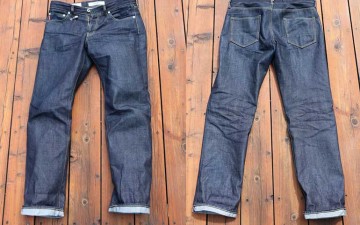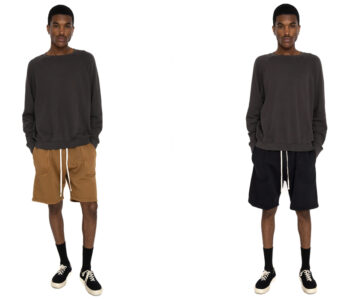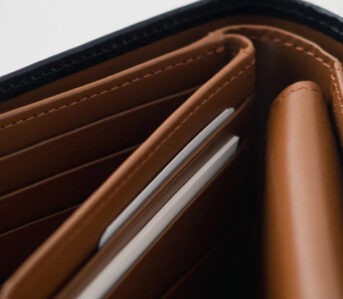Prepare yourselves, denim aficionados, for we’re about to embark on a journey that’s about as controversial as using ketchup on sushi – the daring world of stretch selvedge denim.
In the hallowed halls of Japanese denim craftsmanship, the idea of adding stretch to the sacred fabric has been met with raised eyebrows, disapproving nods, and a collective gasp that could be heard from Okayama to Tokyo. Stretch denim, in this purist paradise, is considered nothing short of heresy, a sacrilegious deviation from the time-honored traditions of raw, rigid denim that’s been celebrated for generations.
But my fellow denim deviants, fear not, for we’re diving headfirst into the controversy to review a pair of jeans that dare to break the mold, that laugh in the face of tradition, and that embrace comfort like a warm bowl of ramen on a chilly night: Hiroshi Kato’s “Julian” jeans – 14oz. of soft, stretchy goodness.
Denim gods; strike me down – let’s get into it.
Details
- Name: Hiroshi Kato Hammer Straight 14oz “Julian”
- Fabric: 96% cotton / 4% polyurethane sanforized 4-way stretch denim
- Fabric source: Japan
- Weight: 14oz.
- Silhouette: Straight (more slim-tapered, but we’ll get into that shortly)
- Unique features:
- 4-way stretch denim
- White hardware/leather patch
- Available for: $268 from Hiroshi Kato.
Fabric
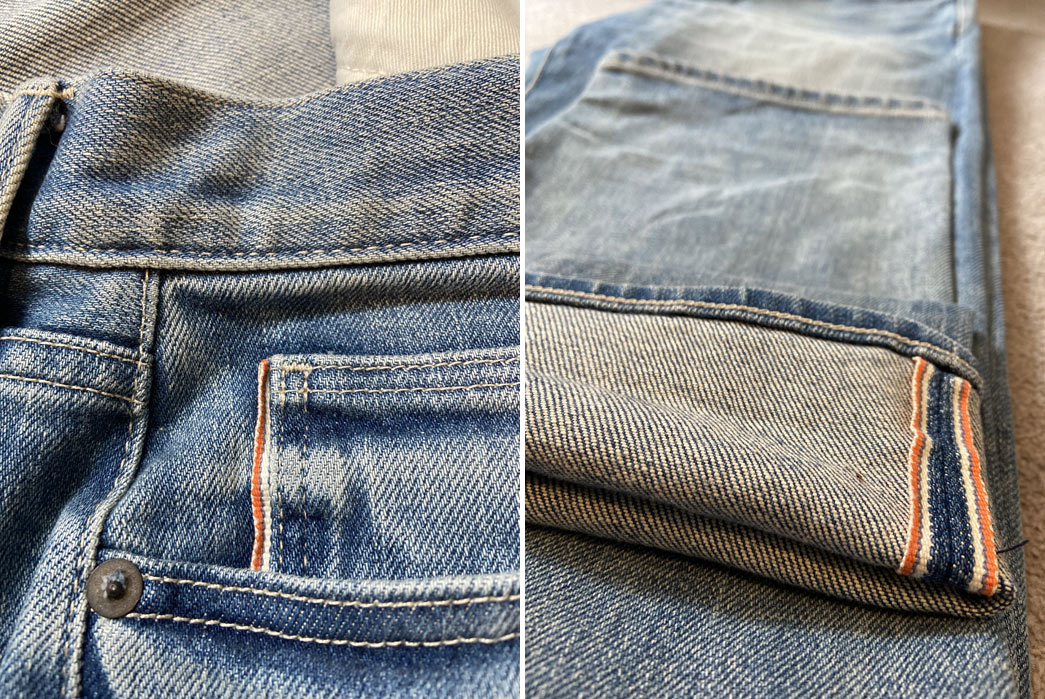
Hiroshi Kato’s four-way stretch denim represents a remarkable innovation in the world of jeans. This fabric combines the timeless appeal of classic denim with the modern comfort and flexibility of stretch materials, creating a harmonious balance between style and movement.
The four-way stretch feature is a game-changer for those who desire the look and feel of authentic denim without sacrificing mobility. Traditional denim can sometimes be restrictive, especially during active moments, but Kato’s four-way stretch denim totally eliminates this issue. It stretches both horizontally and vertically, providing a freedom of movement that’s unparalleled in standard denim.
Despite the stretch, Kato’s denim doesn’t compromise on the durability and character that denim enthusiasts love. The fabric retains the genuine denim texture, weight, and appearance, ensuring that you get the authentic denim experience while enjoying added comfort. This is a significant advantage for those who want jeans that can keep up with their active lifestyle. I wouldn’t recommend hiking in these, just to be clear.
Stretch has come a long way since I last experienced it. In the early days, I remember it would start off great, then progressively bag out until it looked terrible. Having worn these for almost a month now, I’m pleased to say that they haven’t lost the post-stretch silhouette.
The fabric is also incredibly soft. It starts its life in Japan where it’s woven using vintage shuttle looms. Rolls of the fabric are then brought into Kato’s workshop in LA where it goes through a 60 to 90-part process of cutting, sewing, washing, and testing. There’s a misconception among denim heads that “stretch” fabric compromises the structural integrity of the denim, but I see no evidence of that here. I was pleasantly surprised at how substantial these jeans felt out of the bag. Kato has done a brilliant job at finding a harmonious balance between the preservation of artisan methods of manufacturing i.e., vintage shuttle looms, and the necessities of modern-day living.
To put the softness into perspective, I have a pair of three-year-old Pherrow’s 451s that I’ve worn and washed countless times and they’re probably on par with these.
Fit
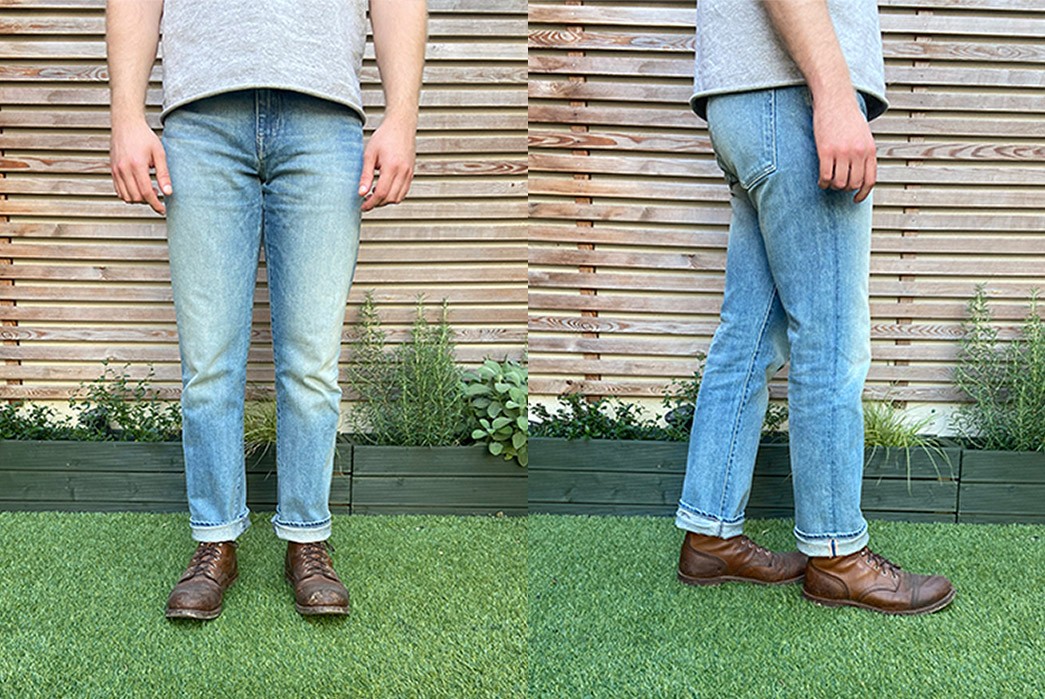
Hiroshi Kato’s “The Hammer” silhouette is labeled as “straight” on the website, but I would say they’re more of a slim straight. In no way is this a dig at the Kato brand. It’s more of an observation of the denim industry more broadly — many brands label fits as ‘straight leg’ when they’re in fact on the slimmer side. It’s important to remember that we’re only just emerging from a decade laden with skinny jeans, so it makes sense that the transition to a ‘true’ straight fit is more gradual.
All jeans have some taper through the leg, even wide-leg jeans. The easiest way to tell how strong the taper is on a pair of ‘straight’ jeans is to look at the thigh (and knee, if available) measurement and compare it with the hem measurement. The closer the hem width is to the thigh and knee widths, the straighter the silhouette. If the hem is half the thigh, then that’s a significant taper.
If you’re a slimmer guy with less meat on the bones in the leg department, then these will look closer to straight on you. If you’re packing in the quad area, these will fit slimmer. If the denim was rigid, that might be a problem. But these are stretch, baby.
Sizing
I’m pleased to report that the measurements listed on the Kato site are in fact accurate; hoorah! It feels like a small win, but the amount of times I’ve ordered denim based on the measurements on the site and they’ve turned out to be inches out is mind-blowing. I’m a true 33” waist, but I decided to size down one, given the stretch. They fit perfectly around the waist post-stretch, but they’re a little tight in the top block. I think Kato’s sizing recommendations are sound. In short, go TTS.
If I’m being nit-picky, I’d like to see an inch or so added to the front rise. I think straighter silhouettes look best when they sit slightly higher on the waist. It’s a proportion thing.
Details
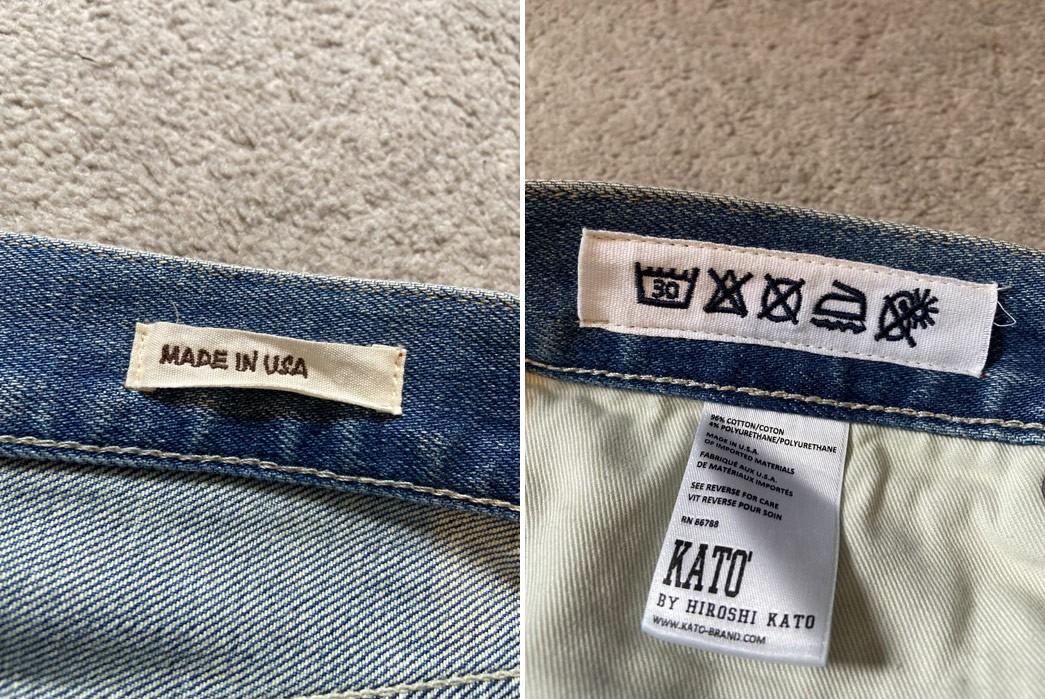
Overall, the details are par for the course for a pair of premium denim jeans at this price point. From selvedge detailing on the coin pocket to YKK hardware, you’re getting what you pay for. But what more do you want? I don’t need my jeans to be compatible with Apple Pay.
I really, really like the hand-drawn mail label embroidered and attached to the inside of the waist belt. Typically, I tend to gravitate towards vintage sportswear labeling, similar to what you’d see on a Velva Sheen tee, for example. Maximalist over minimalist. Kato has totally flipped that on its head. Its labeling is minimalist, readable, and extremely useful. Rather than having to reach for your trusty magnifying glass to read the care instructions, they’re helpfully stitched into the side of the waistband for you. Kato’s waistbands are the denim equivalent of the revolving digital banner ads you see on the front of buildings in Times Square, New York, except the information is useful. Good stuff.
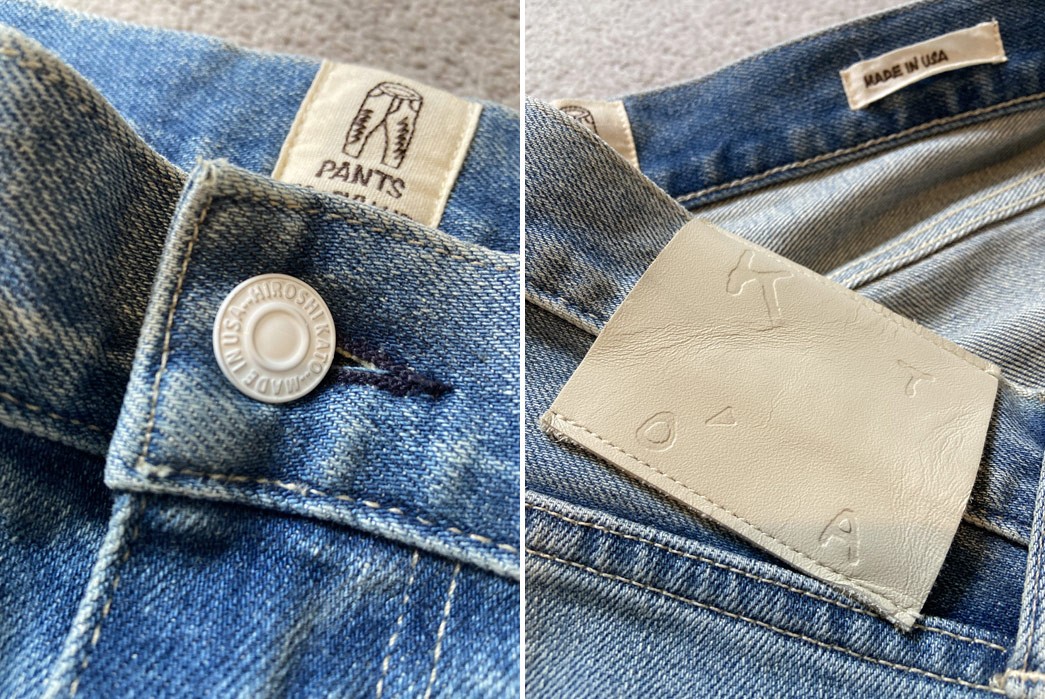
The only potentially divisive detail might be the hardware and leather patch color choice: white. I’m a repro guy, so the only color outside of brass and brown on my denim is the selvedge ID. In fact, this is the first time I’ve seen white used, especially for the leather patch. I don’t hate it, but I wouldn’t choose it if there were any customizability options. That’s purely personal preference, though. It definitely gives the jeans a contemporary feel, which some might strive for.
I went with Kato’s ‘Julian’ vintage wash, because why not? From Elvis Presley to James Dean, many menswear icons of old have rocked the vintage wash. I might look more like Jeremy Clarkson, but it was worth a shot. I’m a big fan of this wash for the warmer months.
Construction
The word I’d use to describe the overall construction is “clean”. Zero loose threads, not too many frills which is a testament to the quality of Kato’s artisan craftsmen.
Standard five-pocket construction with bartack reinforcements throughout, a chain stitched hem, and copper rivets. The belt loops are reinforced from the inside, and the rear pockets have that ornate stitching that extends past the top of the pocket — a feature typical of mid-century five-pocket jeans. Oh, and these have a zip fly! If button flys grind your gears from time to time…
Value
Kato’s “Julian” Hammer jeans aren’t cheap. But, for once, you’re paying for more than the brand. You’re paying for innovation. Kato is a pioneer in the stretch selvedge space, and it’s something that should be lauded, not lambasted.
The quality and detailing aren’t dissimilar from a pair of Japanese denim in the $250 range. Having worn these for just under a month, I’d now happily consider a pair of stretch denim for my rotation if I felt like I wanted to break up the monotony of painstaking break-in periods.
In the grand tapestry of denim, Kato’s “Julian” jeans shine as a stellar example of craftsmanship and innovation. They take the classic, beloved elements of denim and infuse them with a modern twist, creating a versatile, comfortable, and stylish piece of attire. From the impeccable construction to the choice of materials, it’s evident that the Hiroshi Kato team has poured its heart and expertise into every stitch.
Whether you’re a certified denimhead or brand new to the scene, Kato’s “Julian” jeans are a welcome departure from the norm. If comfort is a priority for you, I’d highly recommend at least checking Kato out.

